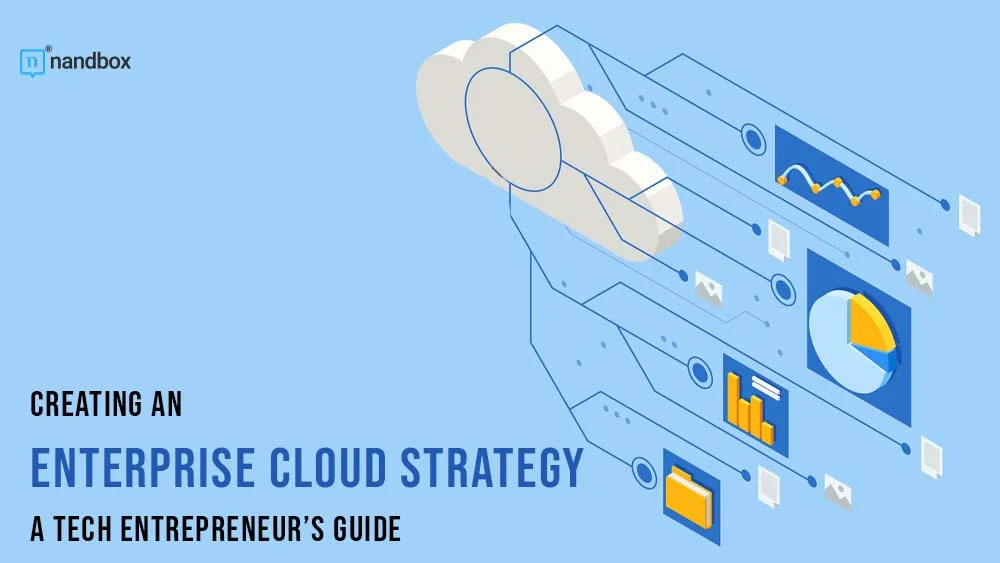Creating an Enterprise Cloud Strategy: A Tech Entrepreneur’s Guide
In order to maintain a competitive advantage in the current market, it is essential to develop an enterprise cloud strategy. This guide will give you the necessary knowledge you need to establish a successful cloud strategy, including key considerations, benefits, and potential problems. This material will be provided to you in the form of a handbook. This book contains all of the information that you require, regardless of whether you are just starting out or looking to enhance your existing cloud infrastructure.
What Is an Enterprise Cloud Strategy?
An enterprise cloud is an integrated IT operating environment that combines private clouds, public clouds, and distributed clouds into a single entity. This environment offers a single point of management to handle infrastructure and applications located in any cloud. Both cloud operators and customers of cloud-delivered services and apps benefit from an experience that is dependable, high-performing, and without interruption thanks to the enterprise cloud’s capabilities.
The enterprise cloud is a model for IT facilities and platform services that provides the advantages of public cloud services for enterprise applications without sacrificing the value that environments housed in private datacenters provide.
Why Use an Enterprise Cloud Strategy?
Large enterprises that have a variety of cloud workloads are perfect candidates for the corporate cloud. The needs that each company has for its use of cloud computing will be unique. Even when circumstances and requirements shift, the IT department is able to adapt workloads to the environment that is the best fit for those workloads thanks to the enterprise cloud. Everything that should be stored on a public cloud is actually stored on a public cloud. On a private cloud, the kinds of applications and data that would be most at home there are stored.
On the other hand, the enterprise cloud architecture enables unified management and governance across the various components that make up the environment. The majority of enterprise clouds offer automated application deployment and maintenance across a variety of environments, all while preserving governance and control. An open strategy that places a premium on adaptability and scalability is the best way for the department of information technology to simplify multicloud governance. End customers are given the ability to self-serve both private and public cloud solutions thanks to enterprise cloud computing.
The following are some of the reasons why a sound cloud strategy should be crafted:
- Define the desired results for your company’s business and the path it will take to get there.
- Determine the primary advantages that can be gained by utilizing cloud computing.
- Determine which services will be developed in-house and which will be provided by a public cloud provider’s partner.
Benefits of Cloud Computing
The use of cloud computing provides businesses in the technology sector with a number of opportunities, including enhanced flexibility, scalability, and cost savings. With cloud computing, organizations are able to flexibly scale their infrastructure up or down depending on their requirements without having to make costly investments in more hardware.
In addition, cloud computing enables remote access to data and apps, which simplifies team collaboration and makes it possible for individuals to operate from virtually any location. In general, cloud computing can assist firms in being more nimble and effective, which enables them to maintain their competitive edge in the fast-moving market of today.
Creating an Enterprise Cloud Strategy: Detailed Steps
IT departments within businesses that are working to upgrade their datacenters are primarily driving the adoption of cloud computing. They want the benefits of the cloud, including its services and service level agreements (SLAs). Along with the same level of safety and management that they have within the datacenter. The Enterprise Cloud is able to fulfill these requirements by offering the “best of both worlds.” Moreover, business owners and app owners are adopting the Enterprise Cloud strategy. That is in order to speed up the process of bringing their products to market. Moreover, avoid delays caused by information technology. That is why we listed for you some of the ways that you can use them to create or plan a great enterprise cloud strategy.
Determine Your Business Needs and Goals
Before developing a plan for the enterprise cloud, it is essential to first define the needs and objectives of your company. This involves doing an audit of your existing information technology infrastructure, making a list of potential areas for enhancement, and establishing concrete goals for your cloud strategy. You might, for instance, be interested in lowering expenses, enhancing scalability, or strengthening data security. If you have a thorough awareness of the requirements and goals of your company, you will be able to devise a cloud strategy that not only complements your overall business plan but also assists you in reaching your goals.
Choose the Right Cloud Service Provider
Selecting the most appropriate cloud service provider is an important step in developing an efficient cloud strategy. Think over things like the provider’s track record. Along with the safety precautions they take, the cost, and how much help they offer their customers. In addition to this, it is essential to make certain that the services offered by the supplier correspond to the requirements of your company. Take the time to do some research and make some comparisons between different service providers before making a choice, and don’t be hesitant to ask for references or speak with current customers to get a better idea of how they’ve been treated.
Develop a Migration Plan
The next step after choosing a cloud service provider is to design a migration strategy for moving your data. This strategy should lay out the procedures that you will take to migrate the data and apps that are now on-premises to the cloud. It is essential to include all relevant stakeholders in this process, such as employees of the information technology department, business leaders, and end users. In addition to a schedule and a financial plan, your migration strategy should also include a backup plan in case any unforeseen problems arise. You can assure a smooth transfer to the cloud and minimize any disruptions to your business operations by preparing a comprehensive migration plan. This will allow you to do both.
Implement Security Measures

It is essential to place a high priority on safety precautions when developing a cloud strategy for a business. This involves the implementation of stringent authentication and access rules, encrypting data both while it is in transit and while it is at rest, and monitoring for potential security risks on a consistent basis. In the event that there is a breach in data security or a loss of data, it is essential to have a disaster recovery strategy in place. You may secure the safety and protection of sensitive data and information pertaining to your company by giving security measures a high priority in your operations.
Difficulties in Developing a Cloud Strategy
Here’s a list of challenges or difficulties that you may encounter when developing an enterprise cloud strategy.
- Failing to put the current plan into action. Having a multi-Cloud strategy in some shape or form is already successful for most businesses. That is in terms of planning and forecasting. Unfortunately, very few businesses actually put the suggested plan into practice. In other words, avoid considering the solid Cloud adoption plan as a notion but rather something that can is better into practice. However, we can resolve this issue. Additionally, assist with the implementation of the strategy. We can be provide you the option of partnering with a reputable provider like N-iX.
- Lack of talent and expertise. In a situation where competition is fierce, finding the greatest Cloud talent might be difficult. A from-scratch plan and migration might turn into a nightmare if your organization has trouble keeping its internal IT personnel. This justifies why more businesses are requesting strategy and planning advice from outside Cloud professionals. Working together with a reputable consulting provider can help you overcome the problem of insufficient skills and knowledge.
- A strategy is a crucial action that is a component of a larger framework in the field of cloud computing. Businesses undergoing digital transformation and cloud migration must manage numerous processes at once. They must deal with security, governance, and other operational procedures in addition to platform modernization. To do that, using a multiphase strategy is essential to ensuring long-term Cloud success. That is what we like to call “strategy complexity.”
Additional Challenges That Can Be an Obstacle in Your Way
- Data compliance and security. Regardless of your IT configuration, moving to the cloud can pose compliance risks. Organizations should stress compliance with numerous security standards and industry recognitions in addition to data security issues. Because of this, more businesses are looking for full-stack Cloud solutions that take compliance and security issues into account beforehand. As an illustration, N-iX collaborates with AWS, Microsoft, and Google, demonstrating its high level of experience in creating cloud-based solutions.
- Companies should evaluate spend management as part of a larger strategy, regardless of size or Cloud maturity. Effective Cloud cost optimization involves preparing a complete Cloud audit to identify idle and unconnected resources. Businesses should think about utilizing projections, cost-cutting technologies from Cloud service providers, and idle resource identification. Here, optimization is crucial because it enables cost savings of thousands of dollars following the Cloud transfer. For instance, AWS Cost Optimization is about more than just finding unused resources. Businesses can leverage tools and optimize resource sizes to significantly cut cloud costs. This frees up the budget for strategic resource allocation, making your cloud environment cost-effective and high-performing.
- Another important point to make is that cloud governance is what we call the secret to effective cloud computing. It’s crucial to clearly define the procedures responsible for ensuring compliance at the strategy step, map out the matrix for responsibility assignment, leverage automation, use as few resources as possible, and limit resource usage. Failure to follow this advice may lead to higher Cloud expenses, inconsistent resource use, greater third-party risk, and sluggish implementation.
Final Thoughts
Now that you’re here, let us emphasize the importance of strengthening your business and empowering it effectively. The development of an application will definitely assure you of a successful business. If you develop an app for your business, you will be able to implement, while doing so, an enterprise cloud strategy that could help you with your management strategies even more!
Creating an app might feel like a daunting task. However, with our no-code native app builder nandbox, the whole process is easier. You simply rely on customizing pre-made professional app templates and our simple drag-and-drop interface and feature addition method.
Sign up now for nandbox’s native no-code app builder and get to create an app from scratch without having to deal with any IT tech development teams that could cloud your app vision!







